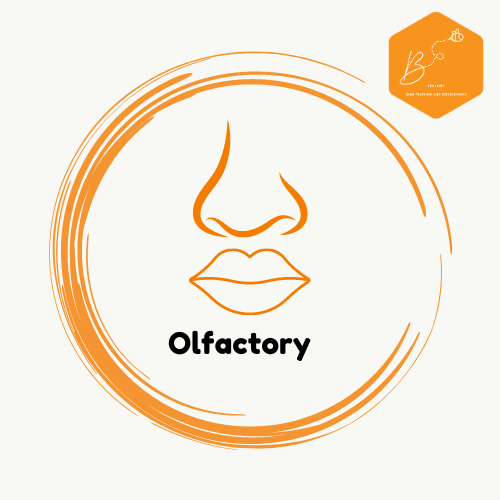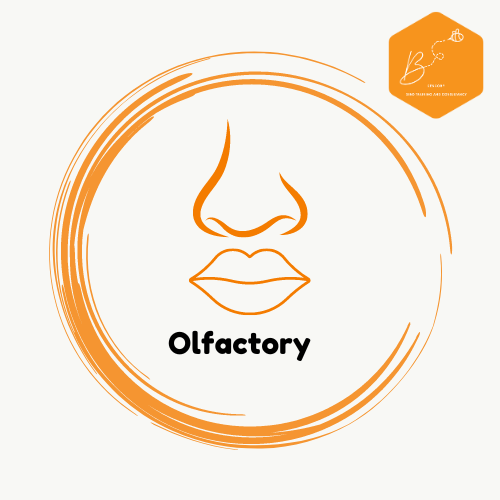Signs and Symptoms of Olfactory and Gustatory Difficulties

Signs and Symptoms
It is essential for professionals and caregivers to be able to identify when somebody is having olfactory and gustatory processing difficulties. As well as sensory profiling people to identify their sensory difficulties, being able to recognise the signs of sensory needs is vital for effective management.

Gustatory Seeking
Here are some signs and symptoms of gustatory sense seeking:
- Constantly Seeking New Flavors: Individuals may constantly seek out new and diverse flavors and foods to satisfy their curiosity and desire for sensory stimulation. They may enjoy experimenting with different cuisines, spices, and ingredients to experience novel tastes and textures.
- Preference for Intense Flavors: Gustatory seekers often have a preference for bold and intense flavors that provide strong sensory experiences. They may enjoy foods that are spicy, sour, sweet, or bitter, and may seek out foods with complex flavor profiles and unique taste combinations.
- Craving for Sensory-rich Foods: Individuals with gustatory seeking tendencies may have a strong craving for sensory-rich foods that provide intense gustatory experiences. They may enjoy foods with varied textures, temperatures, and mouthfeel sensations, such as crunchy, creamy, or chewy foods.
- Eating Excessively or Quickly: Gustatory seekers may eat excessively or quickly in their quest for sensory stimulation. They may have a tendency to overeat or indulge in large quantities of food, particularly foods that provide strong gustatory sensations.
- Preference for Spicy or Flavorful Foods: Individuals with gustatory seeking tendencies may have a preference for spicy or flavorful foods that provide a sensory "kick." They may enjoy foods with added spices, seasonings, or condiments to enhance the taste and intensity of flavors.
- Engagement in Food-related Activities: Gustatory seekers may actively engage in food-related activities such as cooking, baking, or exploring food markets and culinary events. They may enjoy the process of preparing and experimenting with different foods to create sensory-rich experiences.
- Eating non-food items- Seeking and mouthing/digiesting non-food items such as clothing, mud/sand, stationary items, clothes washing tablets, play dough, bodily fluids and excrement and much more.
- Participation in Food Challenges or Eating Contests: Some gustatory seekers may participate in food challenges or eating contests as a way to experience extreme gustatory sensations and push their sensory boundaries. They may enjoy the thrill of testing their taste buds and competing with others in food-related activities.
- Not recognising the feeling of fullness: Gustatory seekers may also have difficulties with their interceptive sense which allows you to know if you feel full or not. Individuals may exsesively eat, eat fast or eat regularly.
- Heightened Sensitivity to Taste: Individuals with gustatory seeking tendencies may have a heightened sensitivity to taste and may be able to detect subtle flavor nuances that others may overlook. They may enjoy savoring and appreciating the intricacies of different flavors and taste profiles.
It's important to note that gustatory seeking behavior can vary in intensity and expression among individuals and may be influenced by factors such as genetics, culture, and personal preferences. While gustatory seeking behavior can be a natural and enjoyable aspect of food exploration, it's essential to maintain a balanced and healthy approach to eating and to be mindful of individual dietary needs and preferences.
Gustatory Avoiding
Here are some signs and symptoms of gustatory sense avoiding behavior:
- Limited Food Choices: Individuals may have a limited range of foods they are willing to eat, avoiding certain tastes, flavors, or textures altogether. They may stick to a narrow selection of familiar foods and be resistant to trying new or unfamiliar foods.
- "Picky Eating": Gustatory avoiders may exhibit "picky" eating behaviours characterised by strong preferences or aversions to specific tastes, textures, or food groups. They may refuse to eat foods with certain flavors, smells, or appearances, leading to limited dietary variety. It is important to note, that this may not be "picky eating" and in fact maybe a sign of ARFID (Avoidant Restrictive Food Intake Disorder). More information on this is one the ARFID page.
- Avoidance of Certain Foods or Ingredients: Individuals may actively avoid or refuse to eat foods that they find unappealing or aversive. They may express disgust or discomfort at the thought of consuming certain foods, ingredients, or food combinations.
- Reluctance to Try New Foods: Gustatory avoiders may be hesitant or reluctant to try new foods or flavors, even when encouraged to do so. They may express anxiety or apprehension about trying unfamiliar foods, fearing negative reactions or unpleasant tastes.
- Physical Discomfort or Nausea: Exposure to certain tastes or flavors may elicit physical discomfort or nausea in gustatory avoiders. They may experience sensations of nausea, gagging, or vomiting in response to specific tastes or food odors.
- Limited Social Dining Experiences: Gustatory avoiders may limit their participation in social dining experiences or food-related activities due to their aversion to certain tastes or flavors. They may avoid restaurants, social gatherings, or events where they anticipate being exposed to foods they dislike. They may also take a lot longer to eat because they may take small bites, rest in-between mouthfuls and/or over chew food.
- Rigid Eating Habits: Individuals with gustatory avoiding behavior may exhibit rigid eating habits and routines to avoid exposure to aversive tastes or flavors. They may prefer to prepare their own meals or eat alone to maintain control over their food choices.
- Preference for Plain or Bland Foods: Gustatory avoiders may gravitate towards plain or bland foods (the toddler diet) with muted flavours and minimal seasoning. They may prefer foods that are mild in taste and avoid foods with strong or complex flavors.
- Discomfort in Food-Related Situations: Gustatory avoiders may experience discomfort or anxiety in food-related situations, such as dining out or attending social gatherings where food is served. They may feel self-conscious or embarrassed about their eating preferences or limitations.
- Impact on Nutritional Status: Gustatory avoiding behavior can impact individuals' nutritional status and dietary quality, leading to imbalances or deficiencies in essential nutrients. Limited dietary variety may result in inadequate intake of nutrients needed for optimal health and well-being.
It's important to recognise that gustatory avoiding behavior can vary in severity and may be influenced by factors such as sensory sensitivities, past food-related experiences, and cultural or familial influences. Encouraging individuals to explore new foods at their own pace, providing positive reinforcement for trying new flavors, and creating a supportive and non-judgmental food environment can help individuals with gustatory avoiding behavior gradually expand their food preferences and experiences.
Olfactory Seeking
Olfactory seeking behaviour refers to the tendency to actively seek out and explore smells, fragrances, and olfactory experiences. Individuals who engage in olfactory seeking behavior may have a heightened interest in and appreciation for scents and may actively seek opportunities to experience a variety of smells.
Here are some signs of olfactory sense seeking behavior:
- Frequent Smelling: Individuals may frequently engage in smelling objects, surfaces, or substances in their environment as a way of exploring and experiencing different scents. They may sniff or inhale deeply to fully immerse themselves in the olfactory experience.
- Interest in Aromatherapy: Olfactory seekers may have an interest in aromatherapy and may use scented oils, candles, or diffusers to create pleasant and relaxing olfactory environments. They may seek out specific scents or essential oils for their perceived mood-enhancing or therapeutic properties.
- Exploration of Natural Scents: Individuals may seek out opportunities to explore natural scents found in the environment, such as flowers, plants, or outdoor settings. They may enjoy taking walks in nature or spending time in gardens to experience a variety of natural aromas.
- Enjoyment of Perfumes and Fragrances: Olfactory seekers may enjoy wearing perfumes, colognes, or fragrances to enhance their personal scent experience. They may have a collection of perfumes or scented products and enjoy experimenting with different fragrances.
- Participation in Scent-related Activities: Individuals may actively seek out activities or experiences that involve smells and aromas, such as cooking, baking, wine tasting, or perfume-making. They may enjoy the process of creating or experiencing different scents and flavors.
- Interest in Scented Products: Olfactory seekers may have a fascination with scented products such as soaps, lotions, candles, or air fresheners. They may enjoy shopping for scented products and exploring different scent options available in stores or online.
- Seeking Out Food Aromas: Individuals may actively seek out opportunities to experience food aromas and flavors. They may enjoy cooking or baking foods with strong or enticing smells and may seek out restaurants or food markets known for their aromatic cuisine.
- Engagement in Scent-related Hobbies: Olfactory seekers may engage in hobbies or activities that involve scent exploration, such as gardening, perfumery, or wine tasting. They may enjoy learning about different scents, ingredients, and scent combinations.
- Use of Scented Personal Care Products: Individuals may use scented personal care products such as scented lotions, body washes, or shampoos as a way of enhancing their sensory experience and enjoying pleasant aromas throughout the day.
- Sharing and Discussing Scent Experiences: Olfactory seekers may enjoy sharing their scent experiences with others and discussing different scents, fragrances, and aromas. They may seek out opportunities to connect with others who share their interest in olfactory exploration.
These signs and behaviors are indicative of individuals who actively seek out and enjoy olfactory experiences, finding pleasure and enjoyment in exploring a variety of smells and fragrances.
Olfactory Avoiding
Olfactory sense avoiding behavior involves a reluctance or avoidance of certain smells, fragrances, or olfactory experiences due to discomfort, aversion, or anxiety. Individuals who engage in olfactory sense avoiding behavior may actively seek to minimize exposure to certain smells or environments where strong odors are present.
Here are some signs of olfactory sense avoiding behavior:
- Physical Avoidance: Individuals may physically avoid places, situations, or environments where strong or unpleasant smells are present. They may actively steer clear of areas such as crowded spaces, restaurants, or public transportation where they anticipate encountering strong odors.
- Avoidance of Certain Foods or Ingredients: Olfactory avoiders may avoid or refuse to eat foods with strong or unfamiliar smells. They may express discomfort or aversion to certain foods, ingredients, or spices, preferring bland or neutral-flavored options.
- Discomfort or Anxiety in Scented Environments: Exposure to strong or unfamiliar smells may elicit feelings of discomfort or anxiety in olfactory avoiders. They may experience physical symptoms such as nausea, headache, or dizziness in response to certain odors.
- Preference for Unscented or Fragrance-Free Products: Olfactory avoiders may prefer to use unscented or fragrance-free personal care products, household cleaners, and detergents to minimize exposure to strong smells. They may seek out products labeled as hypoallergenic or scent-free to avoid triggering reactions.
- Limited Social Engagement: Olfactory avoiders may limit their participation in social activities or gatherings where strong odors are present. They may avoid socializing in settings such as restaurants, bars, or events where food smells or perfumes are prevalent.
- Avoidance of Perfumes and Fragrances: Individuals may avoid wearing perfumes, colognes, or scented products themselves, as well as avoiding close contact with others who wear strong fragrances. They may express discomfort or irritation when exposed to strong synthetic fragrances.
- Preference for Well-Ventilated Spaces: Olfactory avoiders may seek out well-ventilated spaces with good airflow to minimize exposure to strong odors. They may prefer spending time outdoors or in open-air environments where smells are less concentrated.
- Limited Exposure to Cooking Odors: Olfactory avoiders may avoid cooking or preparing foods with strong smells in their own homes. They may opt for simple or quick meal options to minimize the duration and intensity of cooking odors in their living spaces.
- Use of Air Purifiers or Odor Neutralizers: Olfactory avoiders may use air purifiers, odor-neutralizing sprays, or other devices to minimize unpleasant smells in their environment. They may seek out products designed to remove or mask odors to create a more comfortable living space.
- Negative Emotional Responses to Smells: Exposure to certain smells may elicit negative emotional responses such as disgust, frustration, or anxiety in olfactory avoiders. They may express a strong aversion to specific odors and may go to great lengths to avoid encountering them.
These signs and behaviors are indicative of individuals who actively seek to minimize exposure to certain smells or environments where strong odors are present, often due to discomfort, aversion, or anxiety related to olfactory stimuli.




